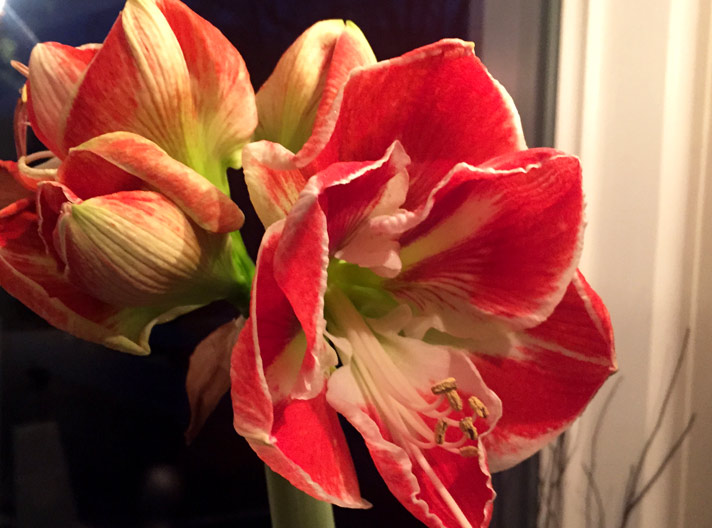The Literary Gardener – December 2016/January 2017
“At Christmas, I no more desire a rose Than wish a snow in May’s newfangled mirth; But like each thing that in season grows.”
– William Shakespeare, “Love’s Labor Lost,” 1598
Oh, Willy, lighten up! Growing flowering plants in winter keeps gardeners gardening and brightens up our wintry world. With a bit of know-how, it’s not difficult to keep some of our outside plants growing and blooming indoors right through the winter, so we needn’t look any further than our cozy homes for a vibrant splash of color or a whiff of heady scent.
Many tender perennials—potted citrus, bamboo, hibiscus, pelargonium, fuchsia, coleus and others—can be brought indoors and kept growing by placing them in a sunny location where nighttime temperatures don’t dip below 55 degrees.
To bring outside plants indoors, first remove dead or yellow leaves from the plants and any debris that’s collected on the soil’s surface. Philodendron and other fast-growing tropical plants, should be pruned back a bit.
Next, remove the plant from its pot and submerge the root ball for 15 minutes in a bucket filled with tepid water and a weak solution of water-soluble insecticide for 15 minutes to get rid of soil-lurking pests. If you intend to replant in the same pot, scrub the pot out with antibacterial soap first; however, now is also a good time to pot up to larger quarters. Either way, use fresh potting soil to replant.
Then, gently spray leaves and stems, first with water and then insecticidal soap or neem oil, repeating this step in two weeks. The soil should be watered thoroughly with an application of high-phosphorous fertilizer. I keep my overwintering plants in a minimally heated enclosed porch with lots of windows so they enjoy as much sunshine as possible.
Keep the soil of your indoor plants just barely moist. Be careful not to overwater by first checking the soil moisture with your finger or a moisture probe. In addition, mist the plants once a week to compensate for the lack of indoor humidity. It’s also a good idea to keep a fan running nearby to provide adequate air circulation. I keep a magnifying glass handy so I can keep an eye out for insects. If I spot any, I’ll pick them off by hand and/or apply more insecticidal soap or neem oil as directed on the product label.
Another way to enjoy indoor gardening during wintertime is to force bloom bulb plants. Although most bulbs, such as tulips, daffodils, hyacinth and crocus, need a long period of cold before they will bloom, other bulb plants that are native to warm climates do not require a chilling period. These include amaryllis (Hippeastrum reginae) and narcissus paperwhites (Narcissus papyraceus).
The indoor plant we commonly think of as amaryllis is actually a different plant altogether. Amaryllis belladonna is native to South Africa and is grown outdoors, whereas the houseplant we call amaryllis is actually from a different genus native to South America.
Regardless of the name confusion, amaryllis is a favorite among indoor winter gardeners because of its tall scape and showy single or double flowers that bloom in various shades of reds, pinks, oranges, whites and multiple colors. Paperwhites are another favorite winter houseplant, not only for their delicate white flowers but also for their strong fragrance.
Both of these bulb plants can be grown either in light, fertile potting soil or in bowls filled with pebbles or marbles and water that covers only the bottom of the bulbs to prevent rot. Plant amaryllis bulbs singly in a pot not much bigger than the bulb so the top third of the bulb is above the soil line. Paperwhites bulbs should be planted about an inch apart so the tips are even with the rim of the pot.
For the first two weeks after planting your amaryllis and paperwhites, set them in a cool, shady place and then move them to a warm, sunny location. Keep the soil moist, but not wet, and fertilize every 2-3 weeks with a half-strength solution. Rotate the plants every few days for even sunlight exposure. You can plant more paperwhite bulbs every 10 days for a profusion of blooms throughout the winter—never mind what William Shakespeare says!

 Rhonda Nowak is a teacher, writer and gardener who lives and works in the Rogue Valley. She has taught literature and language arts for 25 years, the last six at Rogue Community College. In addition to her column for the Jacksonville Review, she writes a weekly column and blog called the Literary Gardener for the Mail Tribune. She also writes articles for Southern Oregon Wine Scene magazine and is writer and editor of Ashland Living magazine. Email Rhonda at Rnowak39@gmail.com.
Read more on her blog at
Rhonda Nowak is a teacher, writer and gardener who lives and works in the Rogue Valley. She has taught literature and language arts for 25 years, the last six at Rogue Community College. In addition to her column for the Jacksonville Review, she writes a weekly column and blog called the Literary Gardener for the Mail Tribune. She also writes articles for Southern Oregon Wine Scene magazine and is writer and editor of Ashland Living magazine. Email Rhonda at Rnowak39@gmail.com.
Read more on her blog at